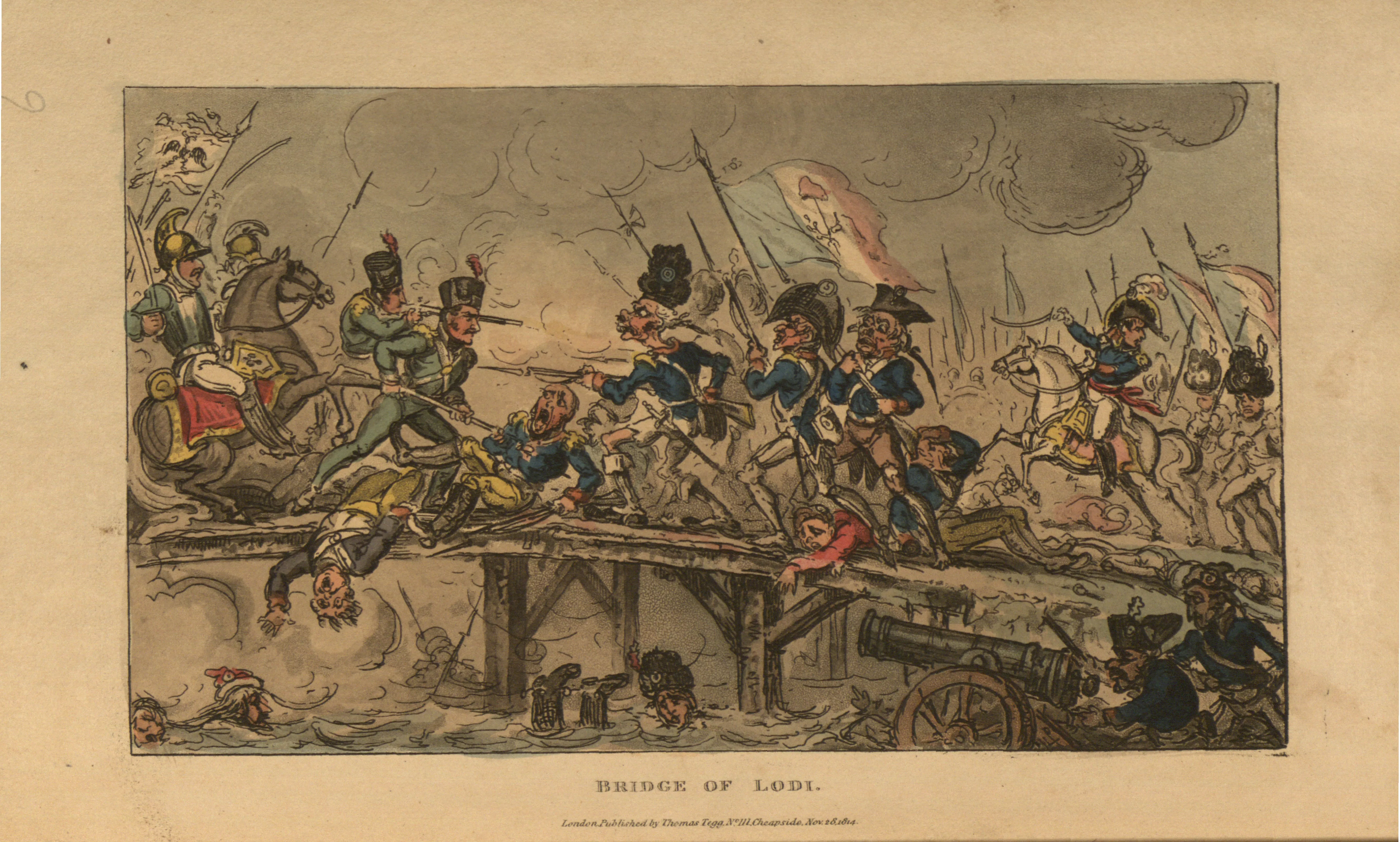Exhibit
Creation Date
28 November 1814
Height
11 cm
Width
19 cm
Medium
Genre
Description
This image depicts the Battle of Lodi, fought by the French forces (led by Napoleon) against the Austrians (Gen. Beaulieu). The French forces, though caricaturized in this image, were victorious.
This image depicts a battle between the French and the Austrians. The Austrians are situated primarily on the left side of the bridge while the French are on the right. The Austrians are wearing green uniforms and the French are wearing blue. Some men on both the Austrian and French side have fallen off the bridge. Napoleon, on horseback, has yet to reach the forefront of the battle. A man on the French side is situated behind a cannon ready to fire. Although there are several flags from both sides in the image, there is a large, albeit moderately altered, French flag positioned nearly in the center of the image. The poles of other, less conspicuous flags are scattered throughout the rest of the print. The sky is cloudy gray and nearly smoky.
The French soldiers are satirized much more harshly than their Austrian counterparts. For example, the French are fighting a battle in their powdered wigs, implying the French tendency towards decadence. Moreover, the wigs are symbolic of the French nobility, which at the time constituted a minority of the population. The French Revolution sought to overturn the social hierarchy, but this image indicates that such a hierarchy was still relevant and in effect. Napoleon, rather than striving for what the people truly desired, a system of social equality, sought world domination.
The Battle of Lodi (May-June 1796) was fought between the Austrians (under General Beaulieu) and the French (under Bonaparte). This battle was a success for the French as the Austrians believed that they (the French) were going to cross the river at one location, when in actuality they intended to cross at a different point. After falling prey to his trap at Lodi, Beaulieu and his men retreated to Cremona while Bonaparte was able to seize Milan and the province of Lombardy. Before the enemy had a chance to close the gates of the town, Napoleon’s men were inside. The assault consisted of “Carabiniers, grenadiers, and sharpshooters” who positioned themselves on small islands (R. Asprey, Reign 312-319). As a result of the victorious battle (only “150 French were lost in comparison to the enemy’s 2000”), his peers deemed Napoleon “The Little Corporal” (R. Asprey, Reign 317).
Political unrest in France existed long before the Napoleonic Wars. During the time of the French Revolution, France’s population was nearly three times as large as the population of Great Britain. Political turmoil in France resulted from their nearly caste-like system which consisted of the clergy (130,000 members), the nobility (400,000 members), and those outside these two privileged classes (24 million members) (R. Obstfeld, Napoleon Bonaparte,13-15). Those who revolted sought a representative government, whether it was a monarchy or not. When Napoleon first rose to power, then, people celebrated the change. However, Napoleon did not remain in favor for long. His political career ended when he was forcibly exiled.
The function of this image is to caricaturize a historical event. The caricature works to satirize the French, whose physical features are highly exaggerated. Conversely, the Austrian army is free of exaggeration. The French are made grotesque in order to emphasize the absurdity of their hunger for conquest. Cruikshank's favorite cartoonist method was to “Ridicule what it is supposed to be celebrating” (A. Cross, "What a World We Make” 178).
As an artist following the brilliant work of James Gillray, Cruikshank struggled to be considered one of the great caricaturists of the Romantic period. The critiques of his work stemmed from his alleged desire to produce “moral comedies” (C. Ashbee, Caricature 6-7); at the time, scholars deemed caricature an art form that completely ignored any concern for justice. However, George Cruikshank sought to dignify “Some of his most fantastic and repulsive scenes with a lofty purpose,” rather than exploiting their ludicrousness (C. Ashbee, Caricature 46).
Locations Description
After defeating the Sardinian forces, Napoleon and his men headed north to attack their allies, the Austrians. The Battle of Lodi occurred in northern Italy, and although the Austrians never intended to protect Lodi, they were forced to do so in the face of uncontrollable circumstances (R. Asprey, Rise and Fall 190).
Publisher
Thomas Tegg
Collection
Accession Number
CA 8938
Additional Information
Bibliography
Ashbee, C.R. Caricature. London: Chapman and Hall Ltd., 1928
Asprey, Robert. The Reign of Napoleon Bonaparte. New York: Basic Books, 2001.
Asprey, Robert. The Rise and Fall of Napoleon Bonaparte. New York: Basic Books, 2000.
Cross, Ashley J. “What a World We Make the Oppressor and the Oppressed: George Cruikshank, Percy Shelley, and the Gendering of Revolution in 1819.” English Literary History, 71 (2004): 167-207.
Combe, William. The Life of Napoleon: A Hudibrastic Poem in Fifteen Cantos. London: T. Tegg III, 1815.
Obstfeld, R. Napoleon Bonaparte, San Diego, CA: Greenhaven Press, Inc., 2001

